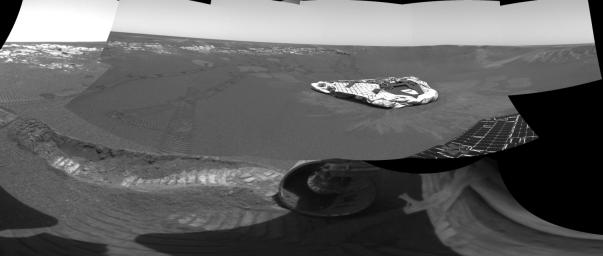Opportunity Trenches Martian Soil
Caption:
The Mars Exploration Rover Opportunity dragged one of its wheels back and forth across the sandy soil at Meridiani Planum to create a hole (bottom left corner) approximately 50 centimeters (19.7 inches) long by 20 centimeters (7.9 inches) wide by 9 centimeters (3.5 inches) deep. The rover's instrument deployment device, or arm, will begin studying the fresh soil at the bottom of this trench later today for clues to its mineral composition and history. Scientists chose this particular site for digging because previous data taken by the rover's miniature thermal emission spectrometer indicated that it contains crystalline hematite, a mineral that sometimes forms in the presence of water. The brightness of the newly-exposed soil is thought to be either intrinsic to the soil itself, or a reflection of the Sun. Opportunity's lander is in the center of the image, and to the left is the rock outcrop lining the inner edge of the small crater that encircles the rover and lander. This mosaic image is made up of data from the rover's navigation and hazard-avoidance cameras.
Cataloging Keywords:
| Name |
Value |
Additional Values |
| Target |
Mars |
|
| System |
|
|
| Target Type |
Planet |
|
| Mission |
Mars Exploration Rover (MER) |
|
| Instrument Host |
Opportunity (MER-B) |
|
| Host Type |
Rover |
|
| Instrument |
Hazard Camera (Hazcam) |
Navigation Camera (Navcam) |
| Detector |
|
|
| Extra Keywords |
Crater, Grayscale, Thermal, Water |
| Acquisition Date |
|
| Release Date |
2004-02-17 |
| Date in Caption |
|
|
| Image Credit |
NASA/JPL |
| Source |
photojournal.jpl.nasa.gov/catalog/PIA05311 |
| Identifier |
PIA05311 |

